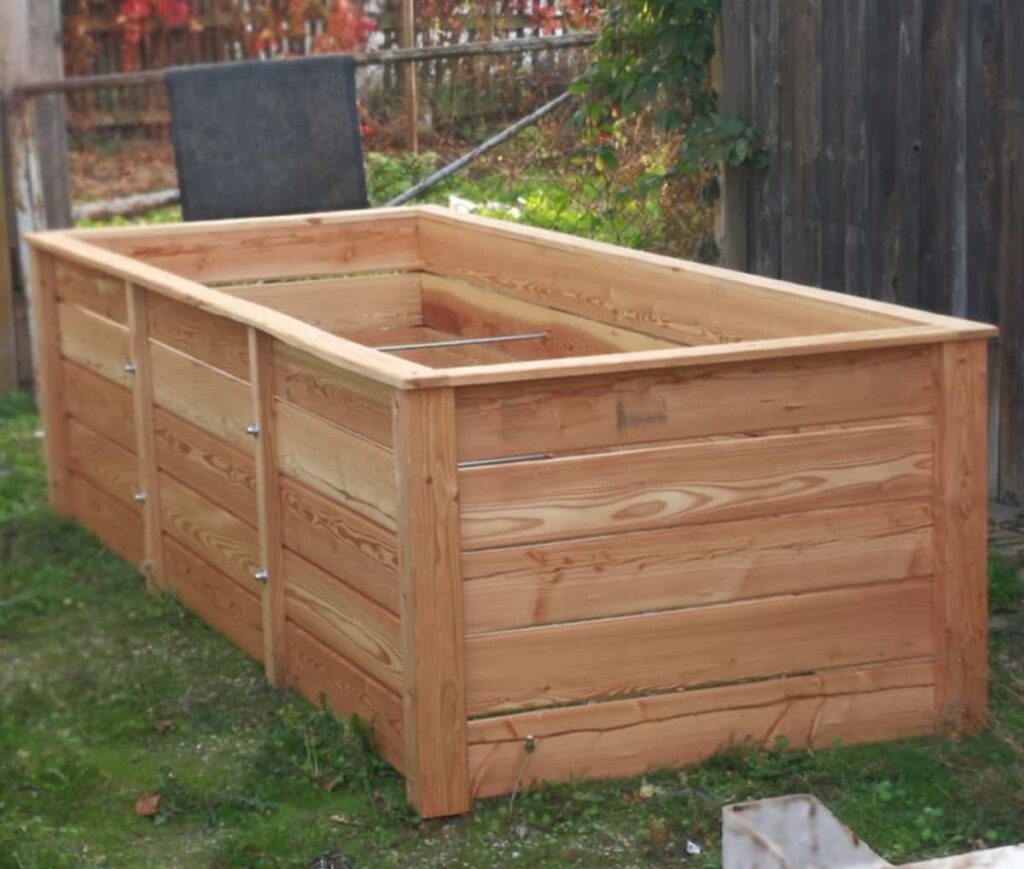Gardening is a great way to enjoy fresh fruits and vegetables while exercising and spending time outdoors. Growing eggplants is a fun and rewarding experience, and raised beds are a great way to do it. This article will provide tips on how to grow eggplants on raised beds. From preparing the soil to watering and fertilizing, we cover everything you need to know to have a successful harvest. So whether you are a beginner gardener or an experienced one, read on for some helpful tips.

How to grow eggplants in raised beds
Types of raised beds for growing vegetables
There are many different types of raised beds that can be used for growing vegetables. Some common types include:
- Elevated or Tiered beds: These raised beds are great for adding height to your garden, which can be helpful if you have limited space. They also make it easier to reach your plants without having to bend over.
- Freestanding beds: Freestanding raised beds are a great option if you want to move them around easily. They can also be used to create different garden designs.
- Built-in beds: Built-in raised beds are a great option if you want a more permanent solution. They can be made from various materials, such as stone or brick, and customized to fit your space.
How to prepare the raised beds for growing eggplants
Eggplants need well-drained, and fertile with a soil pH of 6.0 – 7.0. They also need plenty of organic matter and full sun. If you’re growing eggplants in raised beds, you’ll need to prepare the beds before planting. To prepare the raised beds, start by tilling or digging the soil to a depth of 8 inches. Then, add 2 to 4 inches of compost or any other organic matter to the bed and mix it well. Eggplants are heavy feeders, so they’ll need plenty of nutrients to produce a good crop.
In case you missed it: How to Start Brinjal Farming/Eggplant in West Bengal: Planting to Harvesting Guide for Beginners

Next, level off the bed and ensure it’s free of large clumps of dirt or roots. You want the bed to be as smooth as possible so that the eggplants can grow evenly. Once the bed is prepared, you’re ready to plant your eggplants!
What soil is good for growing eggplants in raised beds?
To grow eggplants in raised beds, you must ensure the soil is of good quality. The best soil for growing eggplants is rich, loamy soil that is well-drained and has a pH of 6.0 to 7.0. You can also use a raised bed mix or garden soil mix that is amended with compost or peat moss.
Eggplant seed germination for raised beds
If you’re looking to start growing eggplants in a raised bed, you’ll need to start by germinating the seeds. Unfortunately, eggplant seeds can be tricky to germinate, so it’s important to follow a few key steps. First, fill a seed tray with a quality potting mix and moisten it well. Then, lightly press the eggplant seeds into the mix, carefully not to bury them too deeply.
Once all the seeds are in place, cover the tray with plastic wrap or a lid and place it in a warm spot. Check on the seeds daily, and once they’ve sprouted, remove the cover and place the tray under grow lights or in a sunny window. Maintain the soil moist but not soggy; within a few weeks, your eggplant seedlings will be ready to transplant into your raised bed.
Planting eggplants in raised beds
If you’re looking for a unique gardening project, try growing eggplants in raised beds! Raised beds are a great way to add interest and variety to your garden, and they’re perfect for growing eggplants. Eggplants are a warm-season crop, so they must be started indoors in late winter or early spring. Sow about ½ inch deep in the moistened seed-starting mix, and keep the soil moist but not soggy.
Seeds will germinate in about 10 to 15 days at a temperature of 70-80 degrees Fahrenheit. Once seedlings have emerged, thin them so that only the strongest plants remain. When they reach 6 to 8 inches tall, transplant them into individual pots. Make sure to harden off your plants before transplanting them into the garden.
In case you missed it: How to Start Eggplant/Brinjal Farming in Malaysia: Check How this Guide Helps to Grow Eggplant

Eggplants prefer a sunny location with well-drained soil. Enrich the soil with compost or manure before planting. Space plants 18 to 24 inches apart, and water regularly during the growing season. Your eggplants are ready to harvest when the fruits are glossy and tender. Cut fruits from the plant with a sharp knife; don’t pull on them, or you may damage the plant.
When to water eggplants in raised beds
Water the eggplants in raised beds when soil becomes dry. On average, eggplants need about 1 inch of water per week. Be sure to water the plants at the base rather than from above to avoid wetting the leaves.
Do you mulch eggplants in a raised bed?
Mulching eggplants in raised beds can help to suppress weeds, conserve moisture, and keep the roots cool. Various mulches can be used, including organic materials such as straw or grass clippings and inorganic materials such as black plastic. When using organic mulches, it is important to replenish them regularly as they will decompose over time.
Caring for eggplants in raised beds
If you’re growing eggplants in raised beds, there are some important things to keep in mind to ensure they thrive. First, eggplants need full-sun and well-drained soils with a pH between 6.0 and 6.8. They’re also heavy feeders, so be sure to amend your soil with compost or manure before planting.
Once your plants are in the raised beds, water them deeply and regularly, especially during dry spells. You will need to place a thick layer of mulch around the plants base to help retain moisture and control weed growth. Fertilize every 2-3 weeks with a balanced fertilizer or compost tea.
In case you missed it: Best Practices to Grow Brinjal/Eggplant at Home: Check How this Guide Helps Beginners

Common eggplant pests and diseases in a raised bed
- Aphids: These small, sap-sucking insects can cause stunted growth and distorted leaves. They are often found in groups on the undersides of leaves.
- Fungal diseases: Eggplants are susceptible to several fungal diseases, including early blight, Alternaria leaf spot, and anthracnose. These diseases can cause spotting or discoloration of the leaves, premature defoliation, and fruit rot.
- Bacterial wilt: This disease is caused by bacteria that clog the plant’s vascular system, preventing water and nutrients from flowing properly. Symptoms include wilting leaves, yellowing foliage, and stunted growth.
To avoid these problems, choose disease-resistant varieties and practice good sanitation by removing infected plant parts. If you notice pests or diseases, take action quickly to prevent them from spreading.
Harvesting eggplants from raised beds
If you’re growing eggplants in raised beds, you’ll need to harvest them when they’re ripe. Here’s how to do it:
- First, check the color of the eggplant. It should be a deep purple color.
- Next, gently press on the skin of the eggplant. If it’s ripe, it will yield to your touch.
- Cut the stem of the eggplant with a sharp knife without damaging the fruit.
- Place the eggplant in a bag or any container and store it in a cool, dry place to increase its shelf life.
When should you stake eggplant in raised beds?
When growing eggplants in raised beds, it is best to stake them when they are about 12 inches tall. This will help support the plant and keep it from toppling over as it grows. Once the plant has reached its full size, you can remove the stakes.
What months do you plant eggplant in raised beds?
If you live in a climate with long, hot summers, you can plant eggplant in raised beds from late April to early June. Eggplant prefers warm weather and does not tolerate frost, so it is important to wait until all danger of frost has passed before planting. In cooler climates, start eggplants indoors in late February or early March and transplant them to raised beds when the weather warms up.
In case you missed it: Top 15 Agricultural Universities in the USA: Best List

Best fertilizers for eggplants in raised beds
When choosing the best fertilizer for eggplants in raised beds, there are a few things to consider. The first is the type of fertilizers you want to use for eggplants. There are organic and synthetic fertilizers available. Both have pros and cons, so research is important before deciding which is right for your raised bed plants. Organic fertilizers are generally considered safer for the environment than synthetic fertilizers but can be more expensive.
Synthetic fertilizers are made from chemicals and can be more effective than organic fertilizers but can also be more harmful to the environment. The second thing to consider is the nutrient content of the fertilizer. Eggplants need lots of nitrogen, phosphorus, and potassium to grow well. You’ll want to choose fertilizers that have a high concentration of these nutrients. Many fertilizers also contain other minerals that can be beneficial for eggplants, such as magnesium and calcium.
Finally, you’ll need to decide how often you want to apply the fertilizer. Eggplants in raised beds will need to be fertilized more frequently than those grown in the ground because they have less access to nutrients in the soil. A general rule of thumb is to apply fertilizer every two weeks during the growing season.
When to harvest eggplants in raised beds
Harvesting eggplants is a delicate process. The fruit is mature when it is glossy and deep purple. However, if the eggplant is left on the plant for too long, it will become overripe and bitter. To determine if an eggplant is ready to be harvested, gently press your thumb into the fruit’s skin. If the indentation springs back, the eggplant is still immature. If the indentation remains, the eggplants are ripe and ready to be harvested. Eggplants are typically harvested in late summer or early fall. However, in warmer climates, they may be harvested year-round.
Tips for growing eggplants in raised beds
If you’re looking to add eggplants to your raised bed garden, there are few things to remember. First, eggplants need full sun and well-drained soil. They also prefer warm weather, so if you’re in a cooler climate, you should wait to plant until the weather has warmed up. When planting, space eggplants 18-24 inches apart. You can start them from seed or transplants. If you’re starting from seed, sow them indoors 6-8 weeks before the last frost date.
In case you missed it: A Complete Guide to Onion Farming in Kenya: Varieties, Planting, Care, Yield, and Profits

Transplants should be planted after the last frost date. Once your eggplants are in the ground, water them regularly and fertilize them every 2 to 4 weeks. Eggplants are ready to harvest when they reach 4-6 inches in length, and the skin is glossy and firm. You will need to cut eggplants with a sharp knife without damaging stems.
Conclusion
If you’re looking for a fun and rewarding gardening project, why not try growing eggplants on raised beds? With a little care and attention, you can produce a bumper crop of delicious eggplants that are perfect for cooking up into your favorite dishes. Follow our tips on how to grow eggplants on raised beds, and you’ll be enjoying homegrown eggplant recipes in no time!
- Profitable Village Farming Business Ideas in 2024
- High-Yield Aquaculture: Fast-Growing Fish for Farming
- Effective Fish Pond Construction Techniques for Beginners
- Irrigation and Water Management in Pineapple Farming
- Blossom to Harvest: Mastering Flowering and Pollination in Papaya Farming
- Pig Fattening Essentials: From Selection to Sale for Beginners
- Raising Wagyu Cattle: A Complete Guide for Premium Beef Production
- Soil Types and Their Water Holding Capacity
- Optimizing Irrigation Schedules for Coconut Groves for Enhanced Yield
- Espresso Your Garden: Coffee Grounds for Healthier Acid-Loving Plants
- The Best Soil Mix for Snake Plants: How to Mix Your Own Snake Plant Soil
- Green Thumb Success: Expert Tips for Cultivating Greenhouse Beans All Year Round
- Bloom All Year Round: The Ultimate Guide to Indoor Hyacinth Care
- Eco-Friendly Gardening: How to Make Liquid Fertilizer from Kitchen Waste
- Ultimate Guide to Grow Anise in Pots: Explore Seed Propagation to Harvesting
- Guide to Raising Chester White Pigs: Discover Breed Facts to Growth Management
- Mastering the Elegance: The Ultimate Guide to Weeping Cherry Tree Care, Planting, and Maintenance
- Ultimate Guide to Planting Garlic in Grow Bags: Growing Strategies for Beginners
- How to Fix Spider Plant Leaf-Related Problems: Natural and Organic Remedies
- 10 Reasons Why Your Tulsi Plant is Shedding Leaves: Home Remedies and Solutions
- Optimizing Growth and Yield: The Advantages of Palm Bunch Ash Fertilizer
- Utilizing Neem Oil Extract as a Natural Pesticide for Hydrangea
- From Soil to Harvest: Various Ways in Which Farmers Can Use AI Tools
- Steps to Encourage and Induce Citrus Flowers: A Comprehensive Guide
- How to Fix Snake Plant Leaf-Related Issues: Natural and Organic Remedies
- Transform Your Garden into a Fragrant Oasis with Raat Ki Rani (Night Blooming Jasmine)
- Discover the Ideal Chicken Breeds for Philippine Farms
- How to Create a Poultry Egg Farm Business Plan for Profits
- Grow Lemon Cucumbers Like a Pro: Insider Techniques for Bountiful Yields
- Ultimate Guide to Caring for Your Pink Princess Philodendron: Tips for Thriving Variegation
- Areca Nut Profit Per Acre: Calculating Yield and Cost of Cultivation
- How Kaveri Chicken is Becoming a More Profitable Breed in Indian Backyards
- Transform Your Barn: 9 Steps to Convert a Horse Stall into a Chicken Coop
- Exploring Suffolk Sheep Disadvantages with Limitations and Challenges
- Guide to Solving Potted Lemon Tree Problems: How to Revive Lemon Tree in Containers
- Steps to Encourage Female Pumpkin Flowers: Best Strategies for More Flowers and High Yields
